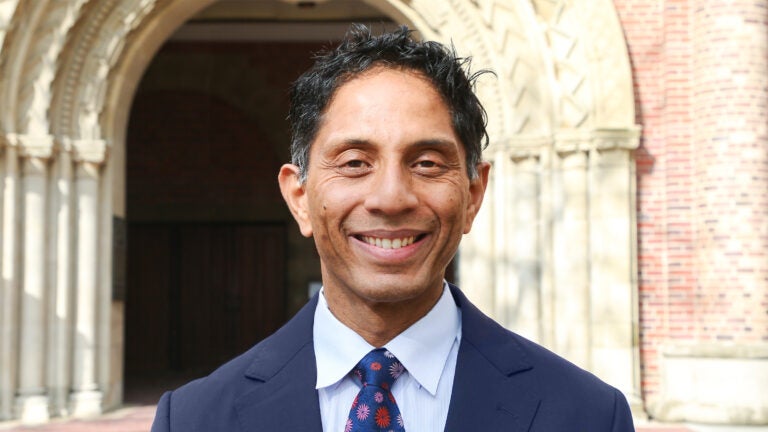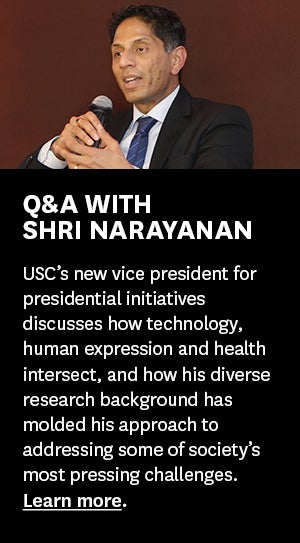
Shri Narayanan has been named USC vice president for presidential initiatives. (Photo/Angel Ahabue)
Shri Narayanan named USC vice president for presidential initiatives
With expertise bridging a wide range of disciplines from computer science to linguistics and medicine, Narayanan will focus on bringing together presidential “moonshots” and expanding their reach.
Shrikanth “Shri” Narayanan, a USC University Professor known for his pioneering research in human-centered sensing, computing and information processing, has been appointed vice president for presidential initiatives, USC President Carol Folt announced Thursday.
Narayanan will be the first to hold this position. An internationally acclaimed scholar, Narayanan holds academic appointments in multiple schools and institutes at USC, including the USC Viterbi School of Engineering, the Keck School of Medicine of USC and the USC Dornsife College of Letters, Arts and Sciences.
 “Advances are taking place at an astonishing rate in the evolving fields encompassed by our ‘moonshots.’ This role was created to focus not only on implementing, but also continually broadening, amplifying and weaving our moonshots together, so USC remains at the forefront of discovery and innovation,” Folt said. “Professor Narayanan is the perfect choice for this role. He has built teams from across multiple schools, locations, disciplines, units and approaches. His energy and innovation are infectious, and the work he takes on flourishes.”
“Advances are taking place at an astonishing rate in the evolving fields encompassed by our ‘moonshots.’ This role was created to focus not only on implementing, but also continually broadening, amplifying and weaving our moonshots together, so USC remains at the forefront of discovery and innovation,” Folt said. “Professor Narayanan is the perfect choice for this role. He has built teams from across multiple schools, locations, disciplines, units and approaches. His energy and innovation are infectious, and the work he takes on flourishes.”
Narayanan begins the role at a pivotal time. The university now is part of an exclusive group of research institutions that have surpassed $1 billion in research spending, thanks to significant investments in the president’s moonshots.
USC also is making rapid progress on the USC Frontiers of Computing initiative, and just celebrated the launch of the USC School of Advanced Computing and the naming of its first director, Gaurav Sukhatme from USC Viterbi. Focusing on bringing these moonshots together will be a primary focus at the outset.
Narayanan’s experience spans academia and industry. A visiting faculty researcher at Google, he holds joint appointments in multiple areas: computer science and electrical engineering, linguistics, psychology, neuroscience, pediatrics, and otolaryngology — head and neck surgery.
“Shri is a Renaissance scholar who understands the why and the how of integrating diverse aspects of USC research to produce meaningful impact,” said Ishwar K. Puri, senior vice president of research and innovation. “Integrating the various presidential initiatives and moonshots will prime USC for research focused on creating a healthier and cleaner world.”
Narayanan will report directly to the president, and will work closely with the university’s senior leadership team, deans, institute directors and scholars from all schools.
“I am inspired by President Folt’s vision of educating the next generation to contribute to society, both individually and collectively,” said Narayanan. “As we advance knowledge across different domains — scientific, technological, creative — we must translate that knowledge into real-world solutions. The collision of creative and technological minds, which USC and Los Angeles are known for, is a powerful engine of innovation.”
Narayanan envisions establishing even more connections through his new role beyond those he has built as a research director at the USC Information Sciences Institute, known for its historic achievements in computer science, and as director of the Signal Analysis and Interpretation Laboratory at USC Viterbi.
A connector who gets results
Throughout his 25 years at the university, Narayanan has been a collaborator. “Shri knows how to combine the rigor of science and engineering with the heart of humanities,” said Yannis C. Yortsos, dean of USC Viterbi. “He has shown in his own work the value of bringing together creative teams, and his enthusiasm for discovery is a powerful force for engaging students, faculty and staff from all fields.”
In 2020, for example, Narayanan and a team of computer scientists and psychologists used artificial intelligence and neuroimaging to uncover surprising connections between musical elements and physiological responses. Their work opened doors for novel music therapy to treat anxiety, pain and even dementia.
Assal Habibi, an associate professor (research) of psychology at USC Dornsife who co-authored the study, said Narayanan “has a unique ability to lead teams with a clear vision, fostering a research environment where creativity and rigor thrive equally.”
In other notable research, Narayanan and his team at the Signal Analysis and Interpretation Laboratory partnered with the Geena Davis Institute on Gender in Media in 2017 to develop an AI tool that uses facial recognition, audio analysis and language processing to objectively track gender bias in Hollywood films.
More recently, Narayanan has spearheaded PRECOG, which harnesses neuroscience, linguistics and human-centered machine learning to improve screening for depression and suicidal ideation. The PRECOG team of USC and UCLA researchers are developing automated screening tools that analyze subtle changes in voice and behavior to paint a more comprehensive picture of mental health and well-being.
Trojan ties run deep
In her letter announcing Narayanan’s position, Folt wrote: “Many of you already know Shri and his infectious energy and passion for discovery. He shares my belief that even the smallest idea can blossom into a world-class solution, particularly if you bring in a wide range of voices from the outset. He tells me he sees a university without walls or boundaries. This is precisely the approach we need to connect and integrate talent, ideas and strengths from across the institution.”
Before Narayanan became a USC scientist, he was a UCLA graduate student who often visited the University Park Campus not just for good food and music with friends, but for the sense of belonging he found at USC.
“I was drawn to USC’s diverse student body, especially its vibrant community of Indian students,” he said. “You’d hear a lot about the ‘Trojan Family,’ but I didn’t fully understand the meaning until years later, after becoming a member and then a parent.”
In 2019 and 2020, Narayanan’s daughter graduated from USC with a Bachelor of Arts and a Master of Arts in English, respectively. He had the honor of presenting her diploma in 2019.
In that moment, the esteemed scholar and researcher was simply a father, beaming with Trojan pride.
“My proudest accomplishment yet,” he said.



